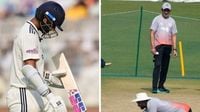The Eden Gardens in Kolkata witnessed a Test match for the ages as South Africa pulled off a historic 30-run victory over India, breaking a 15-year drought on Indian soil. The drama unfolded across just three days, but those 72 hours were packed with controversy, standout performances, and a fierce debate about the very surface on which the battle was waged.
India, led into the series by the young and dynamic Shubman Gill, found themselves at a disadvantage almost from the outset. Gill, who had been in fine form, was forced to leave the field on the second day after experiencing neck pain shortly after scoring a boundary. According to the Board of Control for Cricket in India (BCCI), Gill was “taken to the hospital for examination after the end of day's play” and was “under observation in the hospital. He will take no further part in the Test match. He will continue to be monitored by the BCCI medical team.” His absence left a gaping hole at the top of the order, and with the captain unable to bat, the Indian lineup looked vulnerable.
The first Test of this much-anticipated two-match series started with South Africa winning the toss and electing to bat. The Proteas managed just 159 in their first innings, with the pitch already showing signs of mischief. India replied with 189, eking out a slender 30-run lead, but it was clear this was no ordinary Eden Gardens wicket. The surface, dry and crumbling, quickly became the center of attention and criticism. Former players like Harbhajan Singh labeled it a “mockery” of Test cricket, while ex-England captain Michael Vaughan called it “awful.” The widespread condemnation prompted Cricket Association of Bengal President Sourav Ganguly to defend the pitch, stating, “The pitch is what the Indian camp wanted. This is what happens when you don’t water the pitch for four days. Curator Sujan Mukherjee can’t be blamed.”
India’s coach Gautam Gambhir echoed Ganguly’s sentiments, offering a robust defense of the surface in his post-match press conference. “This pitch is exactly what we asked for and this is what we got. The curator, Sujan Mukherjee, was very supportive. I think it’s a wicket that can judge your mental toughness, because those who played with good defence scored runs,” Gambhir said. “There were no demons in the wicket. This wasn’t an unplayable wicket. Temba Bavuma also made runs, Axar also made runs, Washi also scored. The point is if we always talk about the wicket which you call a turning track, if you see the stats, majority of wickets were taken by seamers.”
Despite the assurances, the numbers told their own story. On day two alone, 16 wickets tumbled as batters struggled to adjust to the unpredictable bounce and sharp turn. India’s bowling coach Morne Morkel admitted, “Yeah, look, I mean, to be honest with you, even we didn’t expect a wicket to deteriorate so quickly, we all thought when we watched that first couple of hours that it was a good wicket, so it did deteriorate quite quickly, which was unexpected.”
South Africa’s Simon Harmer, however, was unfazed by the criticism. The off-spinner led from the front, bagging eight wickets in the match—4-30 in the first innings and 4-21 in the second. “The wickets in 2015 were probably worse. If I think about the wicket in Mohali, it basically disintegrated on day one, and Nagpur was the same — I can remember craters on the wicket,” Harmer remarked. “The ball has spun, but it hasn’t been every single ball. Look, India want to win the Test match and they want to play on wickets that suit them, so we’ve got to find a way to beat them in their own conditions.” And beat them they did.
The third day began with South Africa at 93-7 in their second innings, holding a slim lead of 63 runs. Captain Temba Bavuma, resuming on 29, played a captain’s knock under immense pressure. He stitched together a crucial 44-run partnership with Corbin Bosch, frustrating the Indian bowlers and inching the Proteas toward a defendable total. Bavuma’s unbeaten 55 was the only half-century of the match, a testament to his grit and composure. When Jasprit Bumrah finally broke through to dismiss Bosch for 25, and Mohammed Siraj cleaned up the tail, South Africa were all out for 153, setting India a target of 124.
What followed was a collapse that left the Kolkata crowd stunned. Without Gill at the top, India’s chase never really got going. Marco Jansen struck early, removing both openers—Yashasvi Jaiswal and KL Rahul—leaving the hosts reeling at 1-2. Harmer then took center stage, dismissing Rishabh Pant and Dhruv Jurel, and later pinning Ravindra Jadeja lbw. The wickets kept tumbling, and despite a spirited, boundary-laden cameo from Axar Patel (26 off 17 balls, including two sixes off Maharaj), India’s resistance crumbled. Keshav Maharaj delivered the final blows, taking two wickets in two balls to seal the win. India were bowled out for just 93, falling 30 runs short of the target.
It was a momentous occasion for South Africa, marking their first Test win in India since 2010. Captain Temba Bavuma now boasts an impressive record of 10 wins in 11 Tests as skipper. The Proteas’ bowlers—Harmer, Jansen, and Maharaj—were clinical, exploiting the conditions expertly and never letting India settle. The Indian camp, meanwhile, will be left pondering their approach, the absence of their captain, and the nature of the pitch that was meant to play to their strengths.
The series now moves to Guwahati for the second and final Test, starting November 22, 2025. With Gill’s availability still uncertain as he continues to recover under medical supervision, India faces a tough challenge to level the series. South Africa, buoyed by their historic triumph, will be eyeing a rare series win in India—a feat they last achieved at the turn of the millennium.
Controversy over the pitch may linger, but there’s no denying the drama and excitement that unfolded at Eden Gardens. For South Africa, it’s a victory that will be savored for years to come. For India, it’s a wake-up call and a reminder that in Test cricket, nothing comes easy—especially on home turf.




